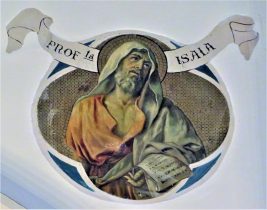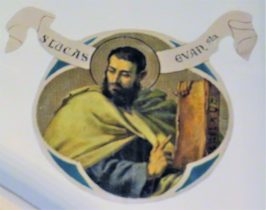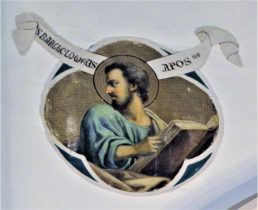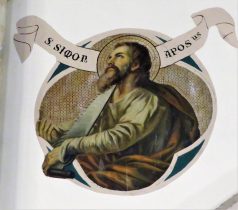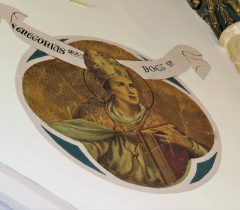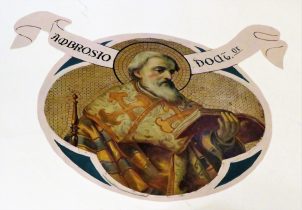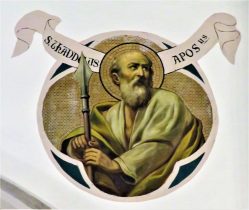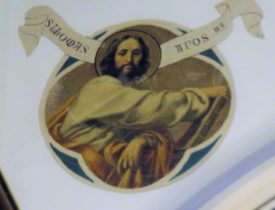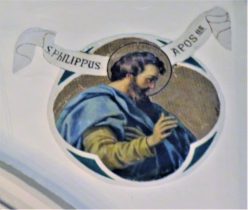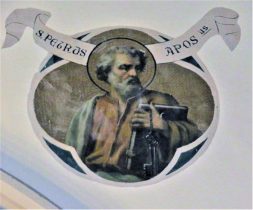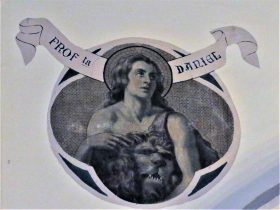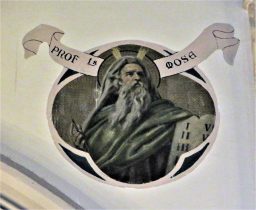Above the arches of the bays, on either side of the arch, are paintings of Old and New Testament figures and Doctors of the Church. They are on canvas and fastened to the wall. Originally there was much blue, green, and gold decorative design around them, filling the entire space between the arches and the clerestory windows. The spelling of the names is an interesting mixture of Latin and Italian, reflecting the painter’s Italian origin.
From front to back there are four Patriarchs, four Prophets, four Evangelists, ten Apostles (two of the evangelists were also apostles), and four Doctors of the Latin or Western Church. The grouping represents the Old Testament, the New Testament and the Church.
Beginning on the right side, proceeding from the sanctuary to the rear of the church, and then returning up the left side to the sanctuary, they are:
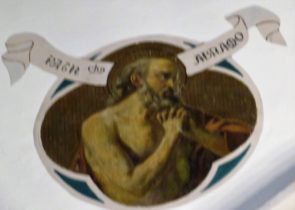 Abramo. Abraham is the common patriarch of the three “Abrahamic religions.” In Judaism, he is the founding father of the Covenant, the special relationship between the Jewish people and God; in Christianity, he is the prototype of all believers, Jewish or Gentile; and in Islam he is seen as a link in the chain of prophets that begins with Adam and culminates in Mohammed.
Abramo. Abraham is the common patriarch of the three “Abrahamic religions.” In Judaism, he is the founding father of the Covenant, the special relationship between the Jewish people and God; in Christianity, he is the prototype of all believers, Jewish or Gentile; and in Islam he is seen as a link in the chain of prophets that begins with Adam and culminates in Mohammed.
Elia. Elijah or Elias, meaning “My God is Yahweh” was, according to the Books of Kings in the Hebrew Bible, a prophet and a miracle worker who lived in the northern kingdom of Israel during the reign of King Ahab (9th century BC). In 1 Kings 18, Elijah defended the worship of the Hebrew God over that of the Canaanite deity Baal. God also performed many miracles through Elijah.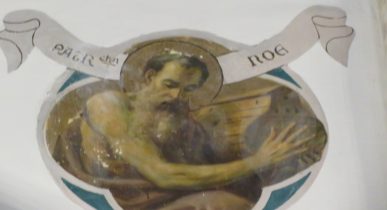
Noe. Noah was the tenth and last of the pre-Flood Patriarchs. The story of Noah’s Ark is told in the Bible’s Genesis flood narrative. His father was Lamech and his mother is not named in the biblical accounts. When Noah was five hundred years old, he became the father of Shem, Ham, and Japheth.
Isaia. Isaiah or Isaias was the 8th-century BC Jewish prophet for whom the Book of Isaiah is named. Within the text of the Book of Isaiah, Isaiah himself is referred to as “the prophet,” but the exact relationship between the Book of Isaiah and any such historical Isaiah is complicated. The traditional view is that all 66 chapters of the book of Isaiah were written by one man, Isaiah, possibly in two periods between 740 BC and c. 686 BC. Another widely-held view is that parts of the first half of the book originated with the historical prophet, and that the remainder of the book dates almost two centuries after the time of the historic prophet.
S. Lucas Evan. Saint Luke the Evangelist is one of the Four Evangelists—the four traditionally ascribed authors of the canonical Gospels. The early church fathers ascribed to him authorship of both the Gospel of Luke and the Acts of the Apostles, which would mean Luke contributed over a quarter of the text of the New Testament, more than any other author.
S. Bartholomaeus Apos. Saint Bartholomew the Apostle was one of the twelve apostles of Jesus. He has been identified with Nathanael or Nathaniel, who appears in the Gospel of John as being introduced to Jesus by Philip (who would also become an apostle), although some modern commentators reject the identification of Nathanael with Bartholomew.
S. Iacobus Mai. Saint James the Greater was one of the twelve apostles of Jesus, and traditionally considered the first apostle to be martyred. He was a son of Zebedee and Salome, and brother of John the Apostle. He is also called James the Greater or James the Great to distinguish him from James, son of Alphaeus (James the Less) and James the “brother of the Lord” (James the Just). James the Greater is the patron saint of Spain, and as such is often identified as Santiago.
S. Simon Apos. Saint Simon the Apostle, often called the Zealot or Simon the Cananite (from Cana) to distinguish him from Simon Peter, was one of the most obscure among the Apostles of Jesus.
S. Gregorius Mag. Doct. Saint Gregory the Great, Doctor of the Church, Pope Gregory I (c. 540 – 604), commonly known as Saint Gregory the Great, was Pope from 3 September 590 to 12 March 604 AD. He is famous for instigating the first recorded large-scale mission from Rome, the Gregorian Mission, to convert the Anglo-Saxons in England to Christianity. Gregory is also well known for his writings, which were more prolific than those of any of his predecessors as Pope. Son of a Roman Senator and Prefect of Rome himself at 30, Gregory entered a monastery but soon returned to active public life. Although he was the first pope from a monastic background, his prior political experiences may have helped him to be a talented administrator, who successfully enhanced papal supremacy.
S. Agustinus Doct. Saint Augustine of Hippo (13 November 354 – 28 August 430) was a Roman African, whose writings influenced the development of Western Christianity and Western Philosophy. He was the bishop of Hippo Regius in north Africa and is viewed as one of the most important Church Fathers in Western Christianity. Among his most important works are The City of God, On Christian Doctrine, and his Confessions.
Ambrosio Doct. Saint Ambrose Doctor. Aurelius Ambrosius (c. 340 – 397), was a bishop of Milan who became one of the most influential ecclesiastical figures of the 4th century. He was the Roman governor of Liguria and Emilia, headquartered in Milan, before being made bishop of Milan by popular acclamation in 374. Ambrose was one of the four original Doctors of the Church, and is the patron saint of Milan. Traditionally, Ambrose is credited with promoting “antiphonal chant”, a style of chanting in which one side of the choir responds alternately to the other.
Girolamo Doct. Saint Jerome Doctor. Jerome (c. 27 March 347 – 30 September 420) was a priest, confessor, theologian, and historian. He was born at Stridon, a village possibly in modern Croatia or Slovenia. He is best known for his translation of most of the Bible into Latin (the translation that became known as the Vulgate), and his commentaries on the Gospels. His list of writings is extensive.
S. Thaddeus Apos. Saint Thaddeus Apostle. Saint Jude was one of the twelve apostles of Jesus. He is generally identified with Thaddeus, and is also variously called Jude Thaddaeus or Judas Thaddaeus. He is clearly distinguished from Judas Iscariot, the apostle who betrayed Jesus prior to his crucifixion. Judas Thaddaeus became known as Jude after early translators of the New Testament from Greek into English sought to distinguish him from Judas Iscariot and subsequently abbreviated his forename.
S. Thomas Apos. Saint Thomas Apostle. Saint Thomas the Apostle, also called Didymus, which means “the twin,” was one of the Twelve Apostles of Jesus. He is informally referred to as “Doubting Thomas” because he doubted Jesus’ resurrection when first told, followed later by his confession of faith, “My Lord and my God,” on seeing Jesus’ wounded body. Traditionally, he is believed to have traveled outside the Roman Empire to preach the Gospel, travelling as far as present-day India. According to tradition, Thomas reached the state of Kerala, India in AD 50 and baptized several people, founding what today are known as Saint Thomas Christians. He is often regarded as the Patron Saint of India.
S. Philippus Apos. Saint Philip Apostle. Philip the Apostle was one of the twelve apostles of Jesus. The Synoptic Gospels list Philip as one of the apostles. The Gospel of John recounts Philip’s calling as a disciple of Jesus. Philip is described as a disciple from the city of Bethsaida, and the evangelist connects him with Andrew and Peter, who were from the same town. He also was among those surrounding John the Baptist when the latter first pointed out Jesus as the Lamb of God.
S. Iacobus Min. Apos. Saint James the Less. The title “The Less”, is used to differentiate James from other people named James. Since it means that he is either the younger or shorter of two, he seems to be compared to one other James. In the lists of the twelve apostles in the Synoptic Gospels, there are two apostles called James, who are differentiated there by their fathers: James, son of Zebedee, and James, son of Alphaeus. Long-standing tradition identifies James, the son of Alphaeus, as James the Less. James, son of Zebedee, is then called “James the Great” (although that designation does not appear in the New Testament).
S. Petrus Apos. Saint Peter the Apostle (died between AD 64 and 68), also known as Simon Peter, Simeon, or Simon was one of the twelve apostles of Jesus Christ. Pope Gregory I the Great called him the “Prince of the Apostles.” Jesus promised Peter in the dialogue in Matthew 16:18 a special position in the Church. “You are Peter and upon this Rock I shall build my Church.” His brother Andrew was also an apostle. Peter was with Jesus during events witnessed by only a few apostles, such as the Transfiguration. According to Christian tradition, Peter was crucified in Rome under Emperor Nero. It is traditionally held that he was crucified upside down at his own request, since he saw himself unworthy to be crucified in the same way as Jesus.
S. Joannes Evan. Saint John Evangelist. Saint John the Evangelist is the name traditionally given to the author of the Gospel of John. Christians have traditionally identified him with John the Apostle. The Gospel of John refers to an otherwise unnamed “disciple whom Jesus loved,” who “bore witness to and wrote the Gospel’s message. The Apostle John was a historical figure, one of the “pillars” of the Jerusalem church after Jesus’ death.[6] He was one of the original twelve apostles and is thought to be the only one to have lived into old age and not be killed for his faith. Some believe that he was exiled (around 95 AD) to the Aegean island of Patmos, where he wrote the Book of Revelation.
Matteus Evan. Saint Matthew Evangelist. Saint Matthew the Apostle, also known as Levi, was one of the twelve apostles of Jesus and one of the four evangelists. Matthew is mentioned in Matthew 9:9 and 10:3 as a publican, or tax collector, in Capernaum who was called to follow Jesus. He is also listed among the twelve in Mark, Luke, and Acts. In passages parallel to Matthew 9:9, both Mark 2:14 and Luke 5:27 describe Jesus’ calling of the tax collector Levi, the son of Alphaeus, but Mark and Luke never explicitly equate this Levi with the Matthew named as one of the twelve.
Prof. Daniel. Prophet Daniel. Daniel’s name means “God (El) is my judge.” While the best known Daniel is the hero of the Book of Daniel who interprets dreams and receives apocalyptic visions, the Bible also briefly mentions three other individuals of this name. Daniel, a noble Jewish youth of Jerusalem, is taken into captivity by Nebuchadnezzar of Babylon and serves the king and his successors with loyalty and ability until the time of the Persian conqueror Cyrus, all the while remaining true to the God of Israel. He is not a prophet in Judaism, but the rabbis reckoned him to be the most distinguished member of the Babylonian diaspora, unsurpassed in piety and good deeds. The Catholic Church recognizes him as a prophet.
When Nebuchadnezzar’s son King Belshazzar uses the vessels from the Jewish temple for his feast, a hand appears and writes a mysterious message on the wall, which only Daniel can interpret; it tells the king that his kingdom will be given to the Medes and Persians, because Belshazzar, unlike Nebuchadnezzar, has not acknowledged the sovereignty of the God of Daniel. The Medes and Persians overthrow Nebuchadnezzar and the new king, Darius the Mede, appoints Daniel to high authority. Jealous rivals attempt to destroy Daniel with an accusation that he worships God instead of the king, and Daniel is thrown into a den of lions, but an angel saves him, his accusers are destroyed, and Daniel is restored to his position
Prof. Mose. Prophet Moses. Moses was adopted by an Egyptian princess, and later in life became the leader of the people of Israel and thier lawgiver. The authorship of the Torah traditionally is attributed to him. According to the Book of Exodus, Moses was born in a time when his people, the Israelites, were an enslaved minority, Moses’ mother secretly hid him when the Pharaoh ordered all newborn Hebrew boys to be killed in order to reduce the population of the Israelites. Through the Pharaoh’s daughter the child was adopted as a foundling and grew up with the Egyptian royal family. After killing an Egyptian slave-master, Moses fled across the Red Sea to Midian, where he encountered The Angel of the Lord, speaking to him from within a burning bush on Mount Horeb. God sent Moses back to Egypt to demand the release of the Israelites from slavery. Moses led the Exodus of the Israelites out of Egypt and across the Red Sea. At Mount Sinai, Moses received the Ten commandments. After 40 years of wandering in the desert, Moses died within sight of the Promised Land on Mount Nebo.
Patr. Isaac. Patriarch Isaac. Isaac is one of the three patriarchs of the Israelites, according to the Book of Genesis. He was the son of Abraham and Sarah and the father of Jacob. His name means “he will laugh,” reflecting when both Abraham and Sarah laughed in disbelief when told that they would have a child. He is the only patriarch whose name was not changed, and the only one who did not move out of Canaan. According to scripture, he died when he was 180 years old.
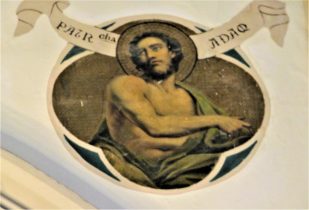
Patriarch Adam
Patr. Adam. Patriarch Adam. Genesis 1 tells of God’s creation of the world and its creatures, with humankind as the last of his creatures: “Male and female created He them, and blessed them, and called their name Adam …” (Genesis 5:2). God blesses mankind, commands them to “be fruitful and multiply,” and gives them “dominion over the fish of the sea, and over the fowl of the air, and over the cattle, and over all the earth, and over every creeping thing that creeps upon the earth” (Genesis 1:26-27).
In Genesis 2, God forms “Adam”, this time meaning a single male human, out of “the dust of the ground” and “breathed into his nostrils the breath of life” (Genesis 2:7). God then places this first man in the Garden of Eden, telling him that “Of every tree of the garden thou may freely eat: But of the tree of the knowledge of good and evil, you shall not eat of it: for in the day that you eat of it you shall surely die” (Genesis 2:16-17). The rest of the story is familiar to us all!

